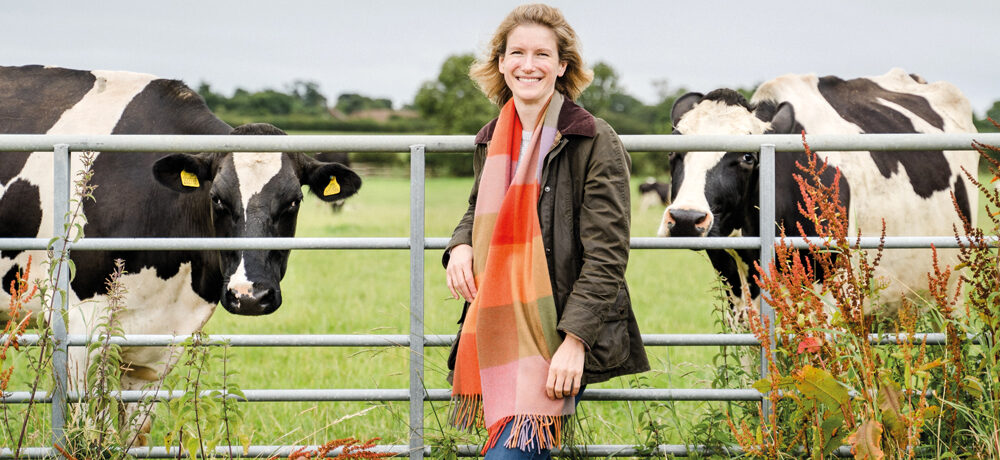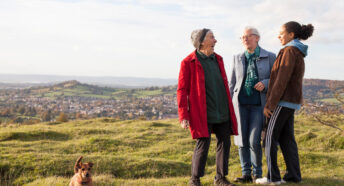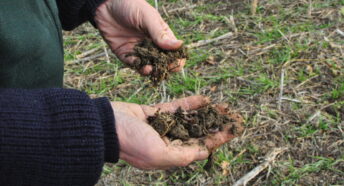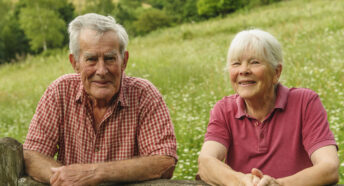The farmers behind our festive dinners
With winter feasting on the horizon, Clare Hargreaves meets the people producing seasonal classics like Stilton, turkey and Brussels sprouts – and finds out why they’re passionate about farming sustainably.
For dairy farmers like Ruth Grice, Christmas Day is a working day like any other, as her family’s 180 Holstein dairy cows need to be milked. But there’s a magical atmosphere in the morning milking parlour, its peace only broken by the snuffling of the black and white cows, the gentle purr of the milking machines and the odd refrain of a Christmas carol. ‘Dad gets up first, at 3.30am, to check everything’s ready for milking,’ she says. ‘The milking crew arrive at 4.30am and let the ladies in – they’re creatures of habit and always in a rush to get in! I help milk the final batches and clean up while Dad gives the cows their breakfast. The milk tanker arrives at eight, and once it’s pulled out of the yard, Dad and I head to the farmhouse to join Mum for scrambled eggs and smoked salmon on toast, and a glassof bubbly. It’s quite a ritual.’
The milk is used by Long Clawson Dairy, five miles away, to make a key course in the Grices’ Christmas lunch a few hours later – the cheese. High in fat and protein, it’s the perfect milk for the Stilton that the dairy has been crafting since 1912. At the dairy, starter cultures are added, as well as rennet, and Penicillium roqueforti, which gives the cheese its distinctive blue veining. The curds are pressed into moulds and the roundels matured for up to 12 weeks to allow flavours to develop.
Love of land
Long Clawson is one of only six dairies authorised to produce Stilton, and under the terms of its protected origin status, these must be in Nottinghamshire, Leicestershire or Derbyshire. Five of those six stand in the vale where Ruth’s family farm stands – the Vale of Belvoir (meaning ‘beautiful view’). Lured by that landscape, her grandfather and great-grandfather bought the farm in 1952.
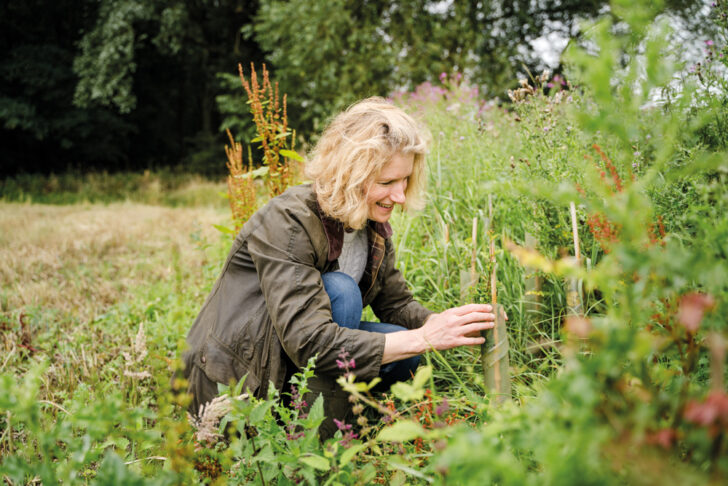
Being a Stilton lover herself (‘I never know when to stop eating it!’), Ruth feels hugely proud that a highlight of many people’s festive cheeseboards is made with milk from her family’s herd. ‘Like the other 30 or so farmers who supply the dairy, we have a real love for our cows and the land we farm on.’
Perhaps surprisingly, milking cows is a relatively new role for Ruth. Although she grew up on the farm, she never intended to be a farmer, and worked for many years at an environmental charity. But after studying at the Royal Agricultural University, in 2018 she started working on the farm part-time, and now combines that with her role as Long Clawson’s sustainability manager and farm liaison. She’s enjoying linking both strands of her career by farming with an eye to sustainability. Among other things, she’s planted over two kilometres of new hedgerows, which provide vital wildlife habitats as well as keeping in the cows. ‘It would break my heart if we couldn’t look after the environment at the same time as running a business,’ says Ruth.
Talking turkey
If it wasn’t for turkeys, Chris Rumming might not have been able to return to his family’s Wiltshire farm. It used to have dairy cows, but around two decades ago Chris’s father converted the farm to high-welfare beef. There was no space for Chris on the farm, so he trained in something completely different – aquatics. But in 2008, he decided to give free-range turkeys a go, and see if he could earn a livelihood on the farm by selling direct to the public.
He’s not looked back, although he admits that producing the main ingredient of many families’ festive dinner is quite a responsibility. ‘Turkey is the centrepiece of Christmas so we have to get it right,’ says Chris, who runs Lydiard Turkeys and its pop-up farm shop with his wife, Lindsay.
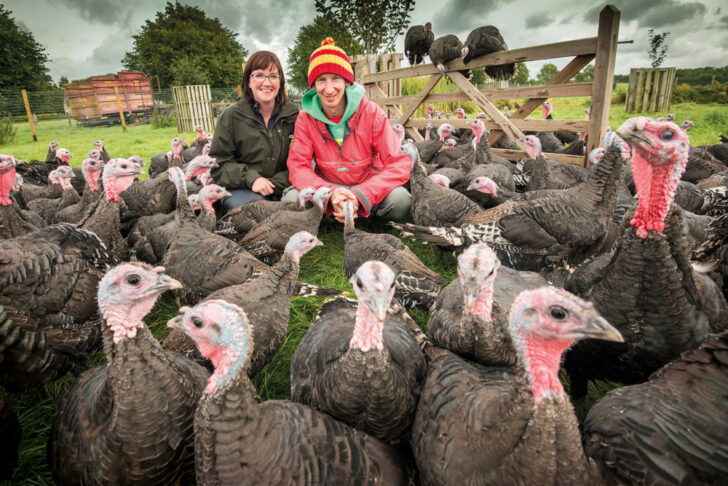
The couple buy one-day-old chicks in June. ‘They’re speckledy-brown balls of fluff when they arrive, but in their first week they double in size,’ says Chris. All are strains of Bronze turkeys, a breed renowned for being slower growing, and higher in flavour and fat content, than industrially farmed Whites.
Free-range life
The turkeys forage in the farm’s paddocks and orchards, which helps save on ever-costlier feeds. ‘Happily, they adore stinging nettles, apple windfalls and elderberries,’
says Chris.
He says his decision to return to the family farm was as much about looking after nature as the bank balance. ‘I saw it as a unique opportunity to help wildlife and the environment. Every single decision I take as a farmer influences the farm’s ecology.’
His cattle graze on former arable land that he’s planted with herbal leys that enrich the farm’s soils and provide a habitat for overwintering birds such as goldfinches. Areas of the farm are left wild to boost biodiversity.
Chris believes these regenerative practices are paying off. ‘We’ve seen growing numbers of spotted flycatchers, which stop off at our farm to hoover up our insects. Kingfishers are breeding here, too.’
But it hasn’t all been plain sailing. Fuel price rises have made refrigeration costlier, and labour is increasingly difficult to find. Then there’s bird flu, which last year forced English turkey farmers, including Chris, to shut up their birds for their final month. ‘Thankfully this year our area has not been affected – so far,’ he says.
On 22 December, the farm buzzes with activity as locals collect their festive birds from the shop. Hopefully, by the end of the next day the turkeys have all gone (‘although there’s usually one person who forgets and rocks up on Christmas Eve,’ laughs Chris).
Finally, Chris and Lindsay get the chance to sample their own produce. ‘I cook the bird upside down, ie breast down, in a hot oven,’ says Chris. ‘When my meat thermometer tells me the meat’s reached 70 degrees, it’s done.’ He likes to pair his turkey with pear and rosemary jelly, a British alternative to imported cranberry. ‘If the turkey tastes amazing, all those anxious months have been worthwhile.’
Brilliant Brussels
Whether you love or loathe sprouts, Christmas dinner wouldn’t be Christmas dinner without them. But spare a thought for the farmers who produce these miraculous miniature cabbages. Getting Mother Nature to cooperate in getting them onto our tables bang on Christmas Day can be quite a challenge.
Jake Richardson’s family knows this better than most, having grown vegetables for four generations. Jake’s great-grandfather bought the family farm in Newby Wiske, North Yorkshire, about 65 years ago, and in 1996 Jake’s father, Peter, converted it to organic. Today, the Richardsons sell all their sprouts to Riverford, which uses them in its weekly organic veg boxes.
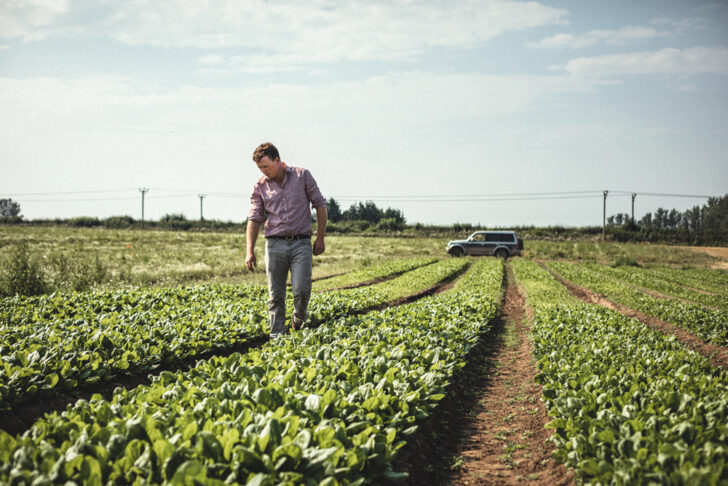
Even in the best of years, hitting the Christmas deadline can be tricky, says Jake. ‘You only have one go. If your potatoes are late, it’s not the end of the world. But with sprouts, people would be very upset if they couldn’t have them for their Christmas dinner. For us it’s a big pressure as many things, like the weather, are out of our control.’
Last year was disastrous. The hot summer weather brought aphids, which then continued devouring the emerald buttons right up until Christmas. The higher temperatures also made the sprouts form far too early – by October. ‘It was the most stressful harvest I can remember,’ says Jake. ‘Instead of the 100 tonnes we’d planned for, we sold just 40. The rest had to be ploughed back into the fields.’
Jake says it’s no wonder many growers have given up, especially those who are paid a pittance by the supermarkets. ‘At least we’re paid sensible prices and have a guaranteed market. Without that, we couldn’t have carried on.’
This year, to insure against pests, Jake is planting late varieties in the hope that by the time the sprouts develop, the aphids will have disappeared. In July he sprayed his crop with garlic to eliminate emerging pests. But this summer presented another challenge – high rainfall, which washed away some of the nutrients that had been carefully ploughed into the soils. ‘This year’s sprouts won’t be large,’ says Jake.
Sprouts not just for Christmas
His busiest week of the year is the one leading up to Christmas, when it’s all hands on deck to get the sprouts out of the ground. He uses a mechanical harvester but that still needs people to drive it – and labour is proving increasingly hard to find. Working from 7am until dark, by the end of 22 December Jake and his nine-strong team will, he hopes, have lifted all his Christmas sprouts.
After all that work, you might think Jake would have seen enough of sprouts. Not a bit of it. He says he can’t eat enough of them. His favourite way is fried or baked with garlic, chilli and smoked bacon. ‘The worst thing you can do is to boil them until they’re soft, which ruins them,’ he says. ‘Fortunately sprouts are becoming far more popular, thanks to chefs demonstrating how to cook them in imaginative ways. And, dare I say it, sprouts are not just for Christmas. I eat them all winter.’
About the author
Clare Hargreaves is a freelance writer specialising in sustainable food and farming.
